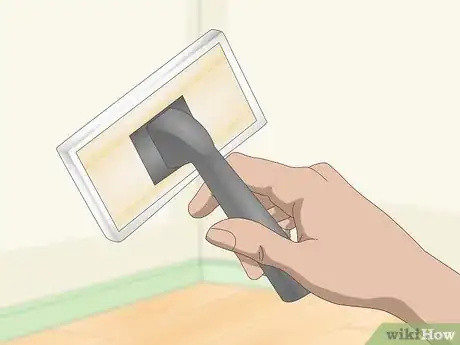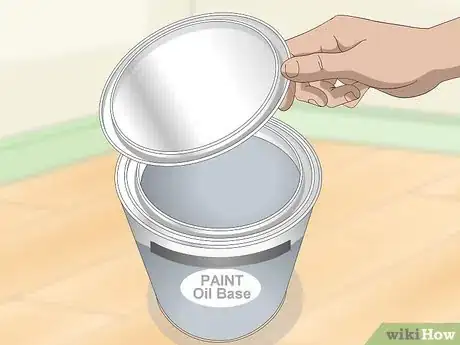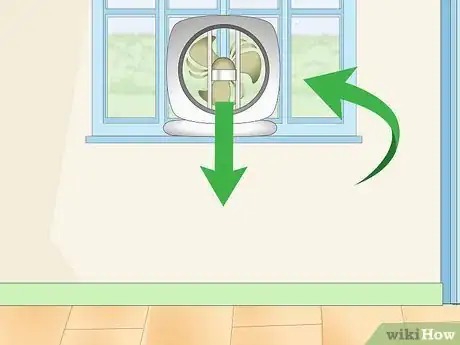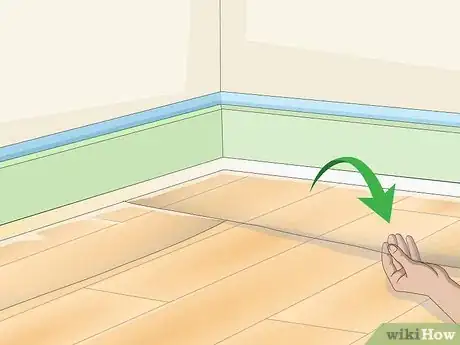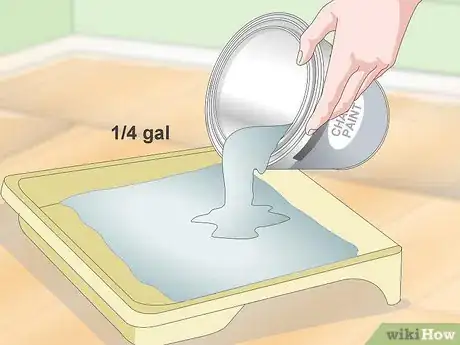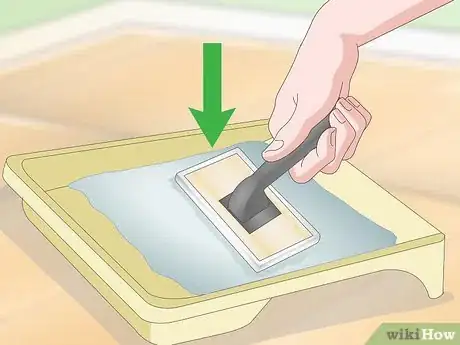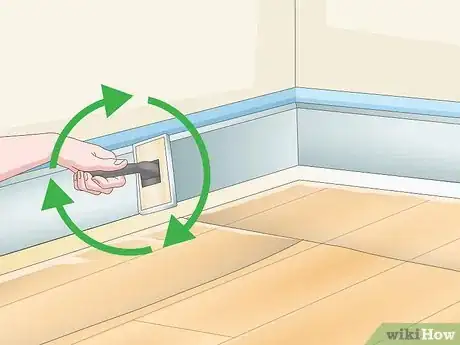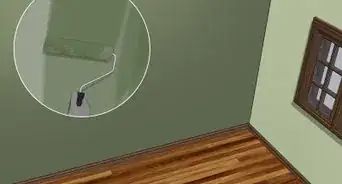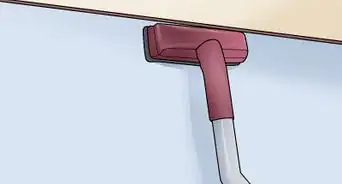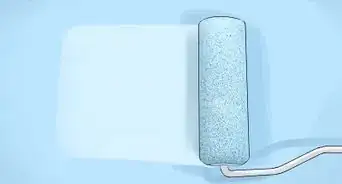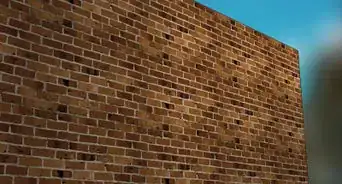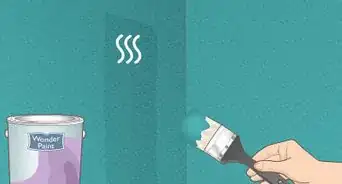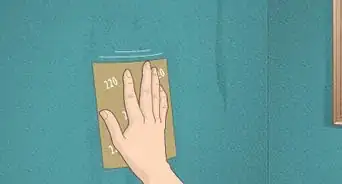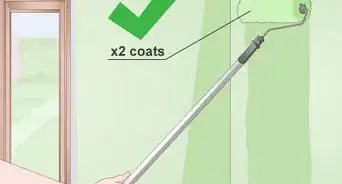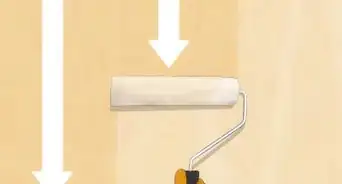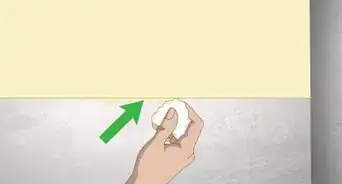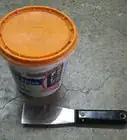This article was co-authored by Crystal Chadwick. Crystal Chadwick is a Licensed General Contractor and the Owner of Yin & Yang Construction out of Salt Lake City, Utah. With over 16 years of experience in the construction industry, she specializes in remodels, repairs, and handyman services. Crystal leads her team with vision and a detail-oriented approach, allowing them to provide quality work and design to their clients.
This article has been viewed 383,214 times.
Baseboards tend to show wear and tear before other areas, and a fresh coat of paint can go a long way toward helping a room feel new again. Our guide has all the tips you need, from what kind of paint to use to how to keep from getting paint on your floors and more!
Steps
Gathering Supplies and Preparing the Room
-
1Purchase painting pads to paint your baseboards with. Using painting pads instead of brushes or rollers will give you a smoother coating of paint on the trim. Additionally, pads are usually the same width as common baseboards, so you can paint the width of the baseboard (from top to bottom) with one stroke. This will also minimize the amount of paint that drips off the trim as you paint.[1]
- Visit a home-improvement store for a good selection of supplies. You can also purchase the necessary supplies to paint your baseboards at a painting store.
-
2Purchase oil-based paint for your baseboards. Oil-based paint is far more durable and dries harder than other types of paint. It can be cleaned with light detergent without damaging the paint’s sheen. Oil-based paints also dry slower than latex or water-based paints, giving you more time to paint. Choose whatever color you like: some homeowners prefer white baseboards, while others like baseboards that match the walls.[2]
- Find a large variety of oil-based paints at a nearby home-improvement store or hardware store.
Advertisement -
3Ventilate the room you’ll be painting baseboards in. Always paint in a well-ventilated room. Open all windows and doors in the room that you’re painting in so you’re not trapped in a room with paint fumes. If the room has no exterior windows or doors, use box fans to direct fresh air into the room.
- Various scented products (e.g., Lysol) can mask the smell of the paint, but the fumes are still present and can be harmful.
-
4Clean off your baseboards to remove dirt and dust. Squeeze a small dollop of dish soap onto a clean cotton rag or washcloth. Dampen the cloth with warm tap water until the soap begins to foam. Then, run the cleaning cloth lightly along the surface of your baseboards to remove any grime, stains, or dirt.[3]
- If your baseboards are already clean and don’t need to be scrubbed, just use the rag to dust the boards.
-
5Mask the baseboards with painter’s tape. Run a strip of tape along the top of the baseboard where it meets the wall. Press the tape firmly into position so that it doesn’t slip while you’re painting. Apply masking tape to all of the baseboards you’ll paint before you start any painting. Masking the baseboards protects the walls from paint, so you can avoid getting paint on the walls while you are painting the baseboards.[4]
- While you can mask with standard masking tape, be aware that it can pull the paint off of the walls when removed.
-
6Lay a sheet of 4 mm (0.16 in) gauge plastic on the floor. This plastic will catch any drips of paint that happen to slide off of the freshly-painted baseboard and will prevent the paint from damaging your floor. Place the sheet of plastic against the bottom of the baseboard. Tape the plastic down with regular masking tape, right where the baseboard meets the floor.[5]
- Purchase large sheets of thin plastic at a hardware store or home-improvement store.
- If you’d rather not buy enough plastic to cover the entire room, you can use 1 large piece and remove it, then re-tape it, for each new section of baseboard that you paint.
Painting the Baseboards
-
1Pour 1⁄4 gallon (0.9 L) of paint into a paint tray. This amount of paint should cover the bottom of the tray to a depth of about 3⁄4 inch (1.9 cm). If your paint looks unevenly colored when you first open the can, use a 1 foot (0.30 m) long wooden painter’s stick to stir the paint. This will ensure that the paint has an even color when you apply it to your trim.
- Purchase a paint tray (either metal or plastic) at a home-supply store or a paint store.
-
2Push the painting pad into the paint. Dip the pad deep enough so that just the sponge part of the pad is covered in paint. Scrape the excess paint off of the pad by running it over the edge of the tray.
- If you dip the painting pad too deep and cover the entire thing with paint, you’ll end up wasting paint when you paint the trim.
-
3Run the painting pad along the baseboard. Hold the painting pad vertical so that its paint-covered face is directly against the baseboard. Slide the pad smoothly along the baseboard from left to right, making strokes that are each about 1 ft (0.30 m) long.[6] Work with precision, since it's better to apply 2 or more thin layers of paint than 1 sloppy layer. Paint the top edge of the baseboard first, then paint the face. This will make sure that you don't damage the face of the baseboard while trying to paint the thinner edge.
- You should be able to paint about 4 feet (1.2 m) of baseboard with each dip in the paint.
-
4Dip the pad back into the tray when it runs out of paint. You’ll notice right away when the painting pad has rubbed its last bit of paint onto the wall. To replenish the paint on the pad, dip it back into the paint tray and cover the sponge with paint, just as you did before. Once the paint is replenished, run the pad along the baseboard until the entire baseboard is painted.
- You’ll end up re-dipping the paint pad many times as you paint the baseboards.
-
5Apply a second coat of paint if the first is translucent. This will be especially necessary if you’re applying light-colored paint over dark-colored trim. Apply the paint thinly, allow it to dry completely, and then apply another thin layer.[7]
- Make sure that you overlap your strokes by about 1 inch (2.5 cm), and that each new section is blended together.
-
6Pull off the painter’s tape and pick up the plastic after 2 hours. The 2-hour waiting period will give the paint plenty of time to dry partially but not completely. Start at 1 end of a long strip of painter’s tape and slowly peel until the full strip has been removed from the baseboards. Also pick up and dispose of the large sheet(s) of plastic that you used to protect the floor.[8]
- If you pull off the painter’s tape after the paint has dried completely, some of the paint may have stuck to the tape. In this case, you’ll tear some of the paint off of the wall when you remove the tape.
Expert Q&A
-
QuestionHow do you prep baseboards before painting?
 Crystal ChadwickCrystal Chadwick is a Licensed General Contractor and the Owner of Yin & Yang Construction out of Salt Lake City, Utah. With over 16 years of experience in the construction industry, she specializes in remodels, repairs, and handyman services. Crystal leads her team with vision and a detail-oriented approach, allowing them to provide quality work and design to their clients.
Crystal ChadwickCrystal Chadwick is a Licensed General Contractor and the Owner of Yin & Yang Construction out of Salt Lake City, Utah. With over 16 years of experience in the construction industry, she specializes in remodels, repairs, and handyman services. Crystal leads her team with vision and a detail-oriented approach, allowing them to provide quality work and design to their clients.
Licensed General Contractor Make sure the baseboards are caulked properly and that the nail holes are filled in all the way and sanded well.
Make sure the baseboards are caulked properly and that the nail holes are filled in all the way and sanded well. -
QuestionHow do you remove painter's tape without removing paint?
 Crystal ChadwickCrystal Chadwick is a Licensed General Contractor and the Owner of Yin & Yang Construction out of Salt Lake City, Utah. With over 16 years of experience in the construction industry, she specializes in remodels, repairs, and handyman services. Crystal leads her team with vision and a detail-oriented approach, allowing them to provide quality work and design to their clients.
Crystal ChadwickCrystal Chadwick is a Licensed General Contractor and the Owner of Yin & Yang Construction out of Salt Lake City, Utah. With over 16 years of experience in the construction industry, she specializes in remodels, repairs, and handyman services. Crystal leads her team with vision and a detail-oriented approach, allowing them to provide quality work and design to their clients.
Licensed General Contractor Use a utility knife to score the edge of the baseboard to prevent any paint from ripping off.
Use a utility knife to score the edge of the baseboard to prevent any paint from ripping off. -
QuestionHow do you paint baseboards perfectly?
 Crystal ChadwickCrystal Chadwick is a Licensed General Contractor and the Owner of Yin & Yang Construction out of Salt Lake City, Utah. With over 16 years of experience in the construction industry, she specializes in remodels, repairs, and handyman services. Crystal leads her team with vision and a detail-oriented approach, allowing them to provide quality work and design to their clients.
Crystal ChadwickCrystal Chadwick is a Licensed General Contractor and the Owner of Yin & Yang Construction out of Salt Lake City, Utah. With over 16 years of experience in the construction industry, she specializes in remodels, repairs, and handyman services. Crystal leads her team with vision and a detail-oriented approach, allowing them to provide quality work and design to their clients.
Licensed General Contractor Make sure you paint all the way next to the tape—don't leave any gaps unpainted.
Make sure you paint all the way next to the tape—don't leave any gaps unpainted.
Things You’ll Need
- Clean rag
- Dish soap
- Box fans (optional)
- Painter’s tape
- Painting pads
- 1 large sheet of 4 mm (0.16 in) gauge plastic
- Oil-based trim paint
- Paint-stirring stick
- Paint tray (metal or plastic)
References
- ↑ https://www.nytimes.com/1982/10/17/nyregion/home-clinic-advantages-of-painting-with-pads-instead-of-brushes.html
- ↑ https://www.familyhandyman.com/painting/tips/trim-painting-tips-for-smooth-and-perfect-results/view-all/
- ↑ https://simplydesigning.porch.com/tips-for-painting-baseboards-flawlessly/
- ↑ https://simplydesigning.porch.com/tips-for-painting-baseboards-flawlessly/
- ↑ https://www.familyhandyman.com/painting/tips/trim-painting-tips-for-smooth-and-perfect-results/view-all/
- ↑ https://www.bobvila.com/articles/how-to-paint-baseboards/
- ↑ https://simplydesigning.porch.com/tips-for-painting-baseboards-flawlessly/
- ↑ https://simplydesigning.porch.com/tips-for-painting-baseboards-flawlessly/
About This Article
Before you paint your baseboards, wipe them down with soap and water to remove any debris. Once they’re dried, dip a painting pad into the paint to cover the sponge and scrape off excess paint on the edge of the tray. Hold the painting pad vertically and press it to the top edge of the baseboard, then dip it back in the paint and paint the face along the same section. Continue all the way around the room and let the paint dry, then add a second coat of paint if the first one isn’t thick enough. Keep reading to learn how to tape off the baseboard so you don’t get paint on the wall!
